Some of the most atypical types of mushrooms are purple. Known for their vivid colors, these mushrooms are mainly believed to be poisonous.
While many can be poisonous, there are purple mushrooms that are edible and even considered to be healthy.
The Northern Hemisphere marks the ideal habitat for these mushrooms which prefer hardwood woodlands and coniferous woodlands.
Some exceptions apply to Central and South American species but most grow in Europe, North America, and Asia.
While most types of purple mushrooms grow next to trees, there are even species that grow on dead trees, soon after these trees die.
Here are some of the most common species of purple mushrooms of the world and what makes them unique together with information on their edible statuses.
Table of Contents
1. Viscid Violet Cort
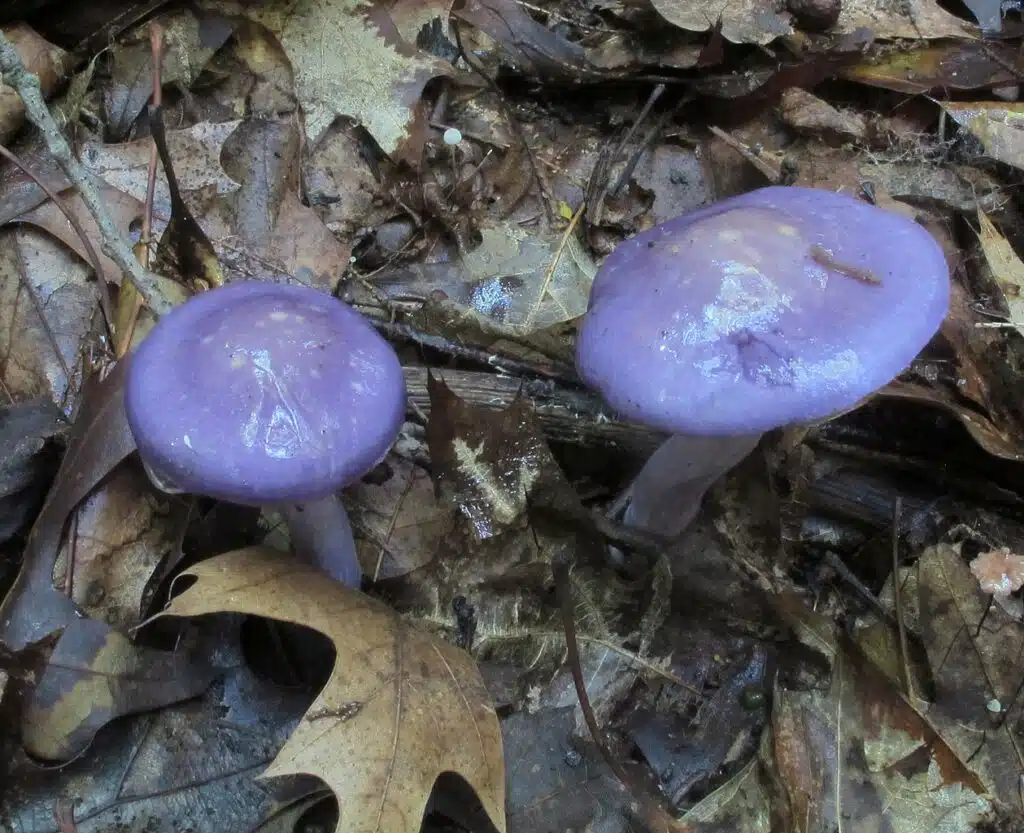
Initially bright purple, Viscid Violet Cort mushrooms (Cortinarius iodes) have a dark violet appearance as they crop.
The purple-violet nuance of their caps is then contrasted by a few small and round yellow spots.
Stipes are also purple with similar yellow and white spots.
Viscid Violet Cort nuances change as the species grows and as its cap turns flat from an initial convex shape.
So where does this colorful mushroom grow? It can be found under deciduous trees in forests of Eastern North America, South America, and Northern Asia.
It only grows under hardwood trees and it prefers higher-humidity soils covered in leaves.
2. Blewit
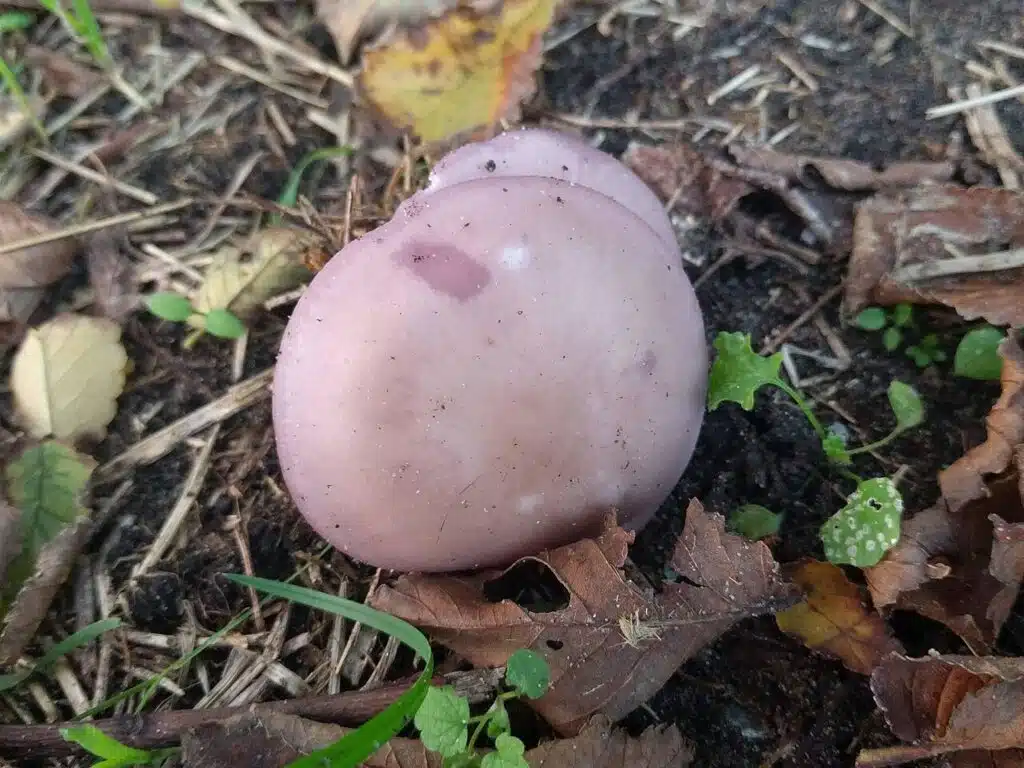
Blewit mushrooms (Lepista nuda) are some of the largest types of purple mushrooms in the world.
Their caps can even reach a diameter of almost 6 inches, which makes them easy to correctly identify.
The coloring of their caps varies from an initial bright nuance to lavender, purple, or violet nuances once the cap flattens out as it grows.
While the stem has a tan nuance, it may also show white or purple interpretations as it grows as well.
Coniferous forests in France, Great Britain, and The United States are among the places where the species grows.
By most sources, Blewit mushrooms are edible and even tasty, but only when cooked. Some allergy-like reactions may be spotted in some individuals, but only when the mushroom is eaten raw, which isn’t recommended.
Drying them or cooking them with oil or butter in a pan is recommended.
3. Shellfish-scented Russula
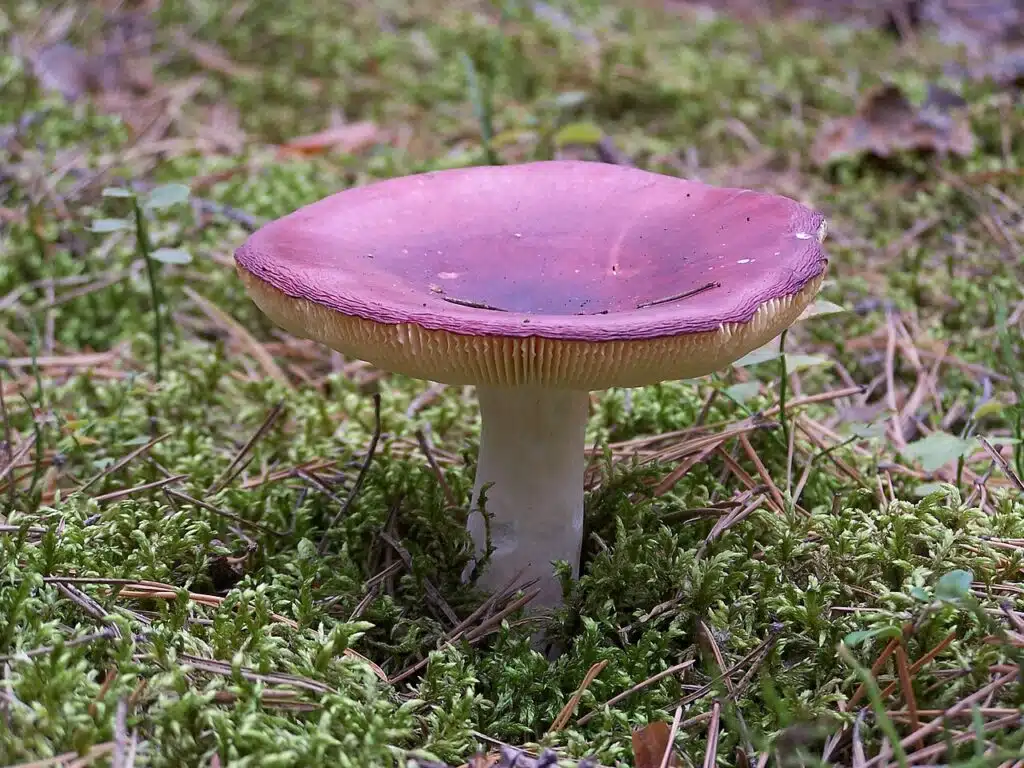
A few types of colors are seen on the caps of Shellfish-scented Russulas (Russula xerampelina). From brown to purple, these large mushrooms grow into different colors with contrasting white stipes.
These types of mushrooms are some of the tastiest mushrooms of the Russula genus.
Some people say the younger mushrooms taste best as the older ones get a more pronounced acidic shrimp-like taste.
Multiple cooking methods are considered for the species which can grow large.
Some of the largest Shellfish-scented Russulas grow to a cap diameter of 8 inches or more.
This is also among the species that grow in European and North American forests. Coniferous forests are their ideal habitat on both continents.
4. Primrose Brittlegill
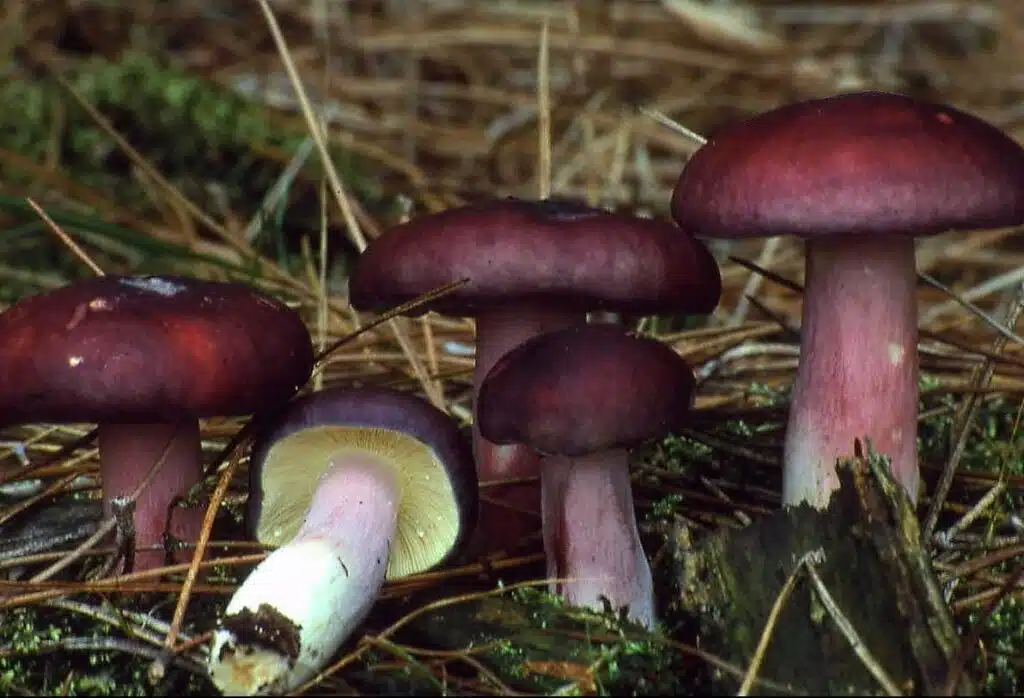
Deep purple colors cover the top of Primrose’s Brittlegill mushroom (Russula sardonia). The central area of the cap is mostly dark purple as the cap grows.
Unlike other mushrooms, Primrose Brittlegills eventually get a yellow cap nuance as they reach their maximum growth.
A species of coniferous woodlands, Primrose Brittlegills grows both in Europe and North America.
Adapted to cooler climates, they are sometimes eaten albeit some sources don’t recommend eating them.
The edible status of the species can be further debated as Primrose Brittlegills have a peppery taste and may not be the first choice for picked mushrooms.
Those who do decide to pick it do this in its early days when its cap is purple.
5. Purple Brittlegill

Purple Brittlegills (Russula atropurpurea) are also known as Black Brittlegills due to their darker central cap color. They are also known as some of the most common britlegills.
These mushrooms further show dark purple coloring on the inner cap and bright purple nuances on the margins of the cap.
A vividly-colored species, these mushrooms have all-white stipes and cream-to-white gills.
Like other types of brittlegills, the mushrooms are common in the woodlands of Europe and North America.
They may be known for a paler purple nuance in areas with heavy rain such as Northern Ireland and Great Britain.
6. Humpback Brittlegill
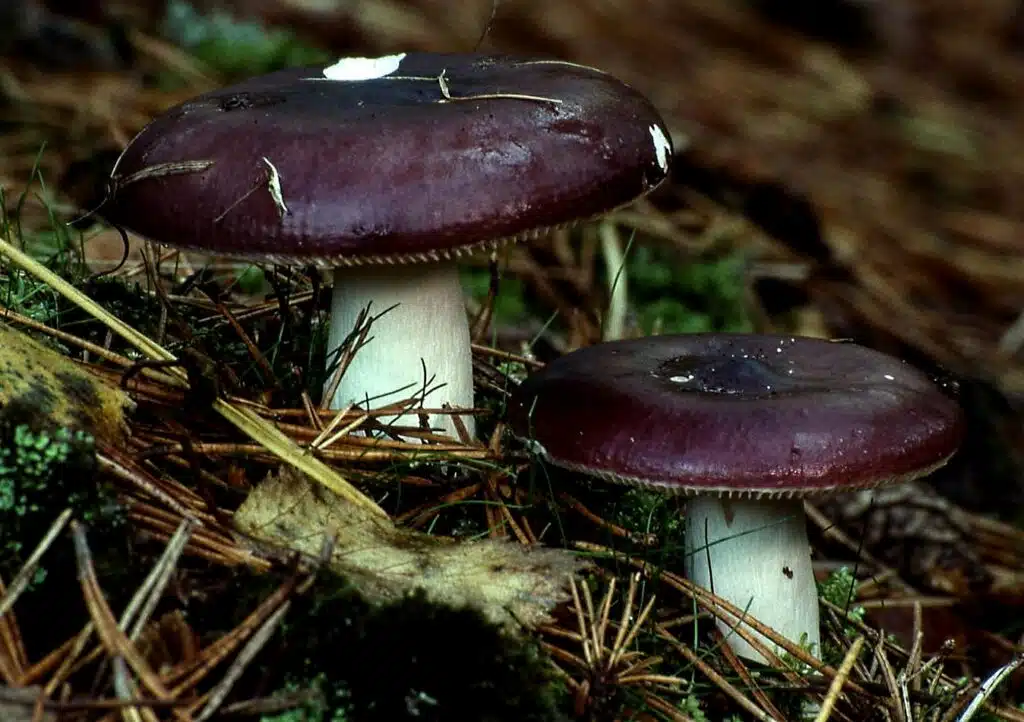
Dark and bright purple nuances are characteristic of the cap of Humpback Brittlegills (Russula caerulea).
A darker purple central cap which is almost black is specific through their growth stages.
Purple-brown nuances are also common on Humpback Brtitlegills.
A species that grows to a cap size of up to 4 inches, the mushroom grows in deciduous mixed hardwood woodlands as well as in coniferous areas.
It can be picked in Europe, North America, and Asia in the summer and into the fall.
Known to be edible, the species is disliked by taste in some cases. Its cap is believed to need peeling to have a more pleasant aroma although these mushrooms aren’t as aromatic as others.
Although large, these mushrooms tend to grow solitary.
7. Violet Coral Fungus
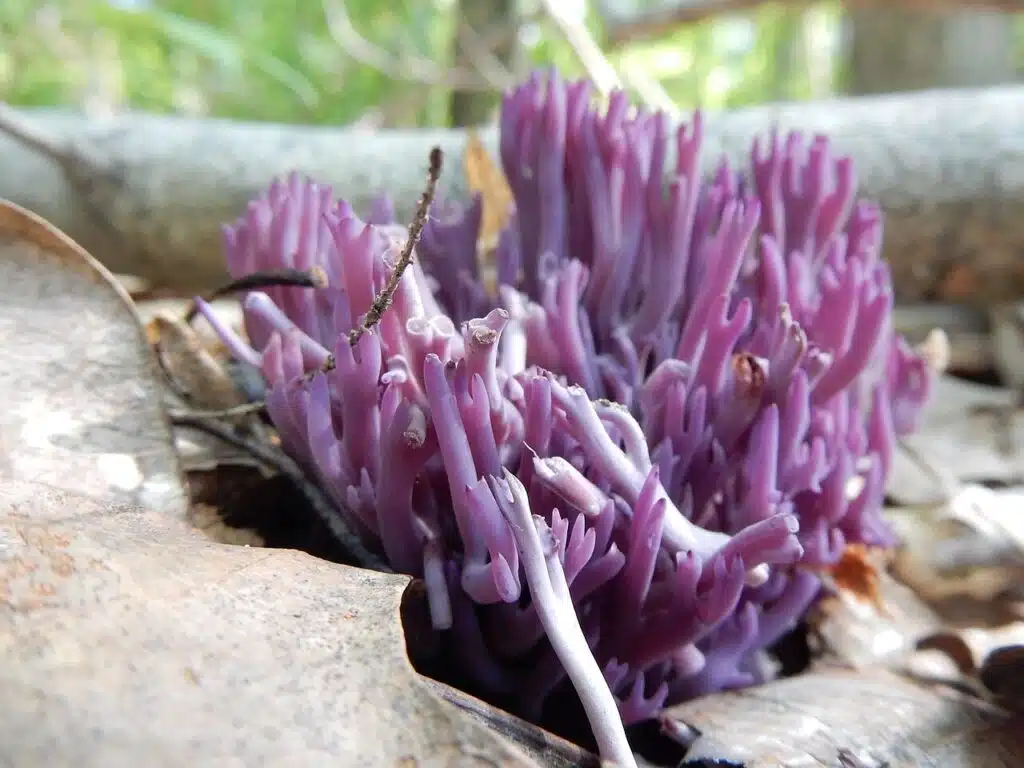
A bright purple nuance covers The Violet Coral Fungus (Clavaria zollingeri).
The name of the fungus is inspired by its atypical shape which is reminiscent of corals.
The fruit bodies of the fungus grow to a size of several inches and are brighter violet at the bottom and violet-purple at the top.
Some of these fungi grow in Europe, mainly close to hardwood trees. They grow in forests as well as in grassland.
Most commonly, Violet Coral Fungi grow in areas with mosses.
The edible status of the fungi is also unclear. By some sources, these fungi can be eaten, albeit in small quantities.
Other sources claim that fungi should not be eaten as it can cause an upset stomach.
The taste of Violet Coral Fungus fruit bodies is also reported to be unpleasant.
8. Lilac Bonnet
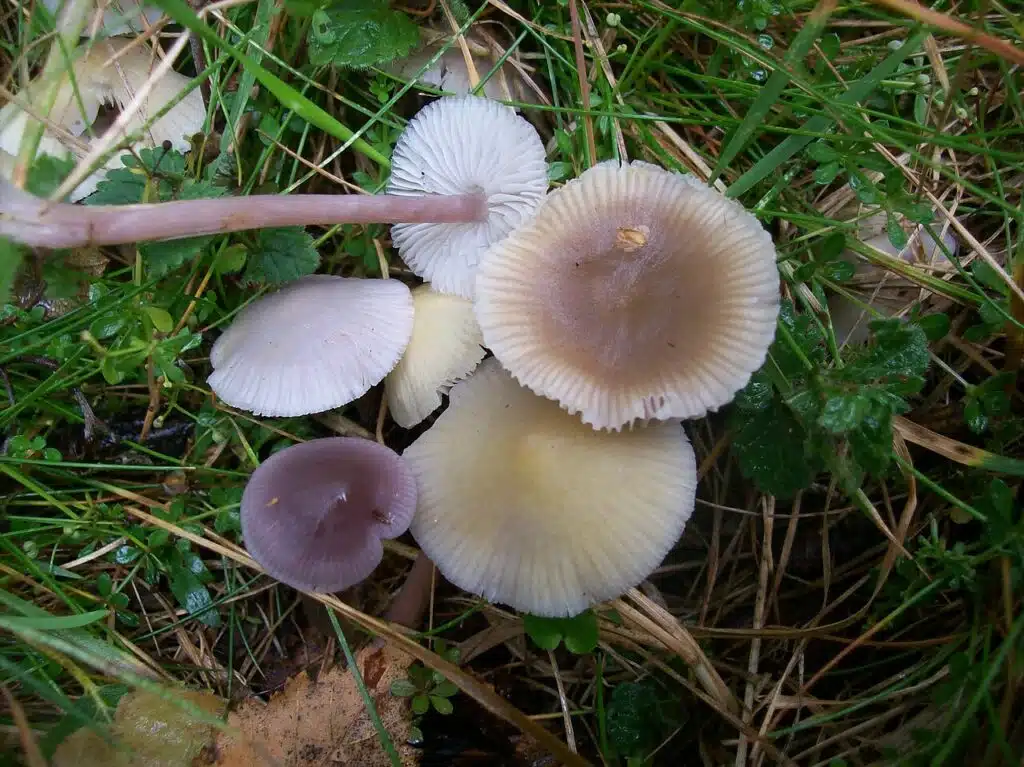
Lilac-purple nuances are specific to The Lilac Bonnet (Mycena pura) a species with a darker inner cap at first.
The inner cap then becomes brighter, as it flattens out with a growing diameter.
There are also white, tan, and brown Lilac Bonnets as the final color of their caps is influenced by their very specific habitat.
Growing among pine trees, Lilac Bonnets are among the highly poisonous mushrooms.
The species is common in Europe. In North America, Lilac Bonnets grow in pine woodlands and in oak woodlands to a lesser extent.
Depending on these locations, Lilac Bonnets can have white, pink, or bright purple stipe coloring.
9. Violet Webcap
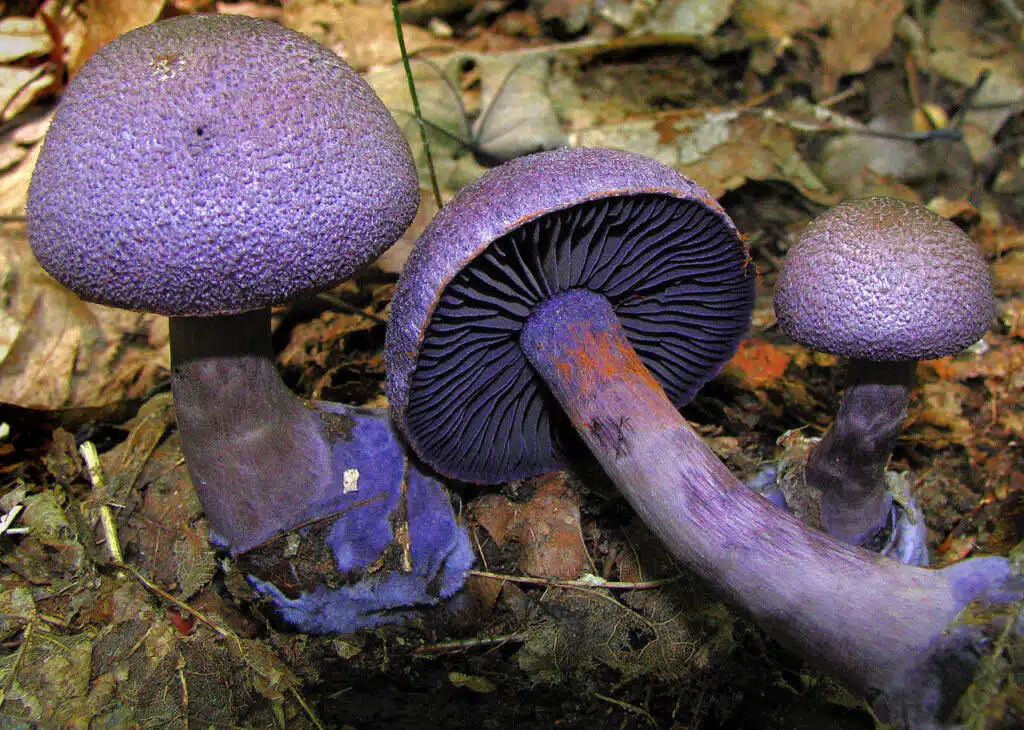
Violet Webcpas (Cortinarius violaceus) are some of the rarest types of purple mushrooms in the world.
They grow in small numbers in hardwood forests and coniferous woodlands across Europe, North America, Asia, and Australia.
Dark purple nuances dominate their dome-shaped caps and their stipes alike.
Even the flesh of these mushrooms has a bright purple appearance.
Purple nuances of a brighter appearance are further distinguished on the gills.
Most people stay away from these mushrooms due to their vivid coloring and scarcity. By some sources, they are edible but others claim they are poisonous.
The taste of the species is believed to be influenced by its habitat. Violet Webcaps in oak woodlands taste of oak.
10. Purple-bloom Russula
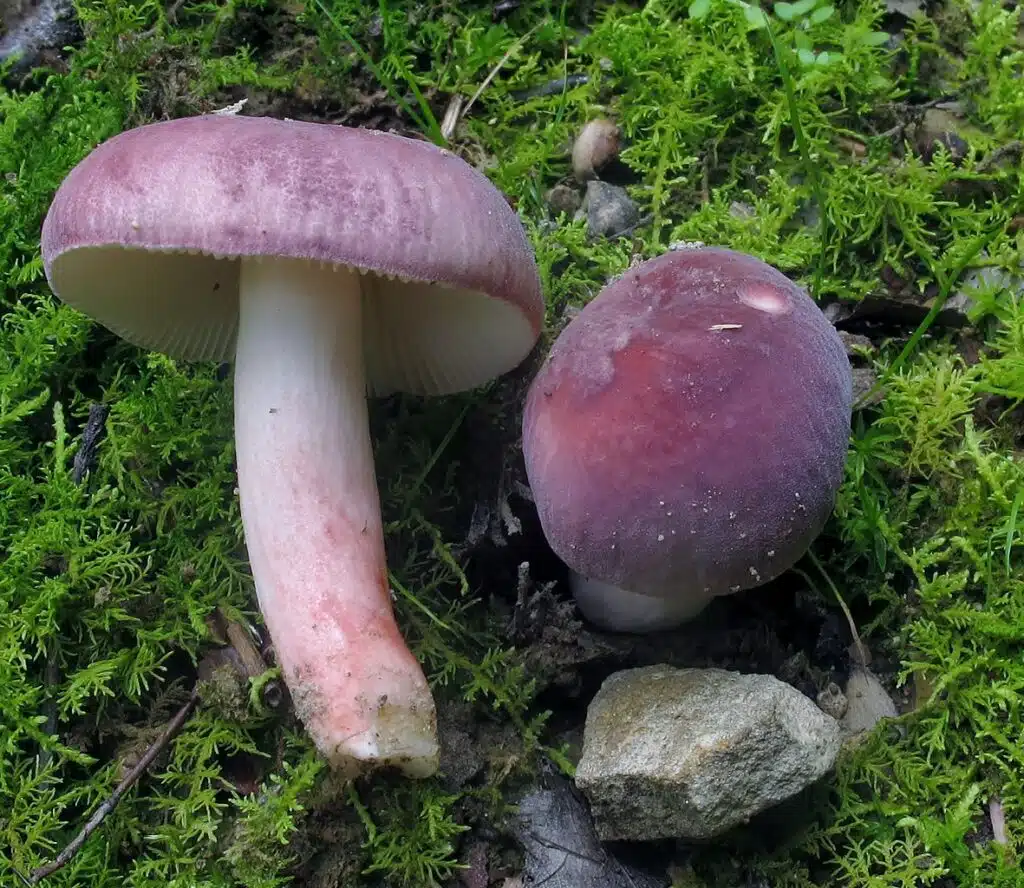
Some types of purple mushrooms are found across all types of deciduous hardwood forests in North America.
Purple-bloom Russulas (Russula mariae) are among the most common of these mushrooms, particularly in the Eastern side of The United States.
Pink-purple, purple, and violet nuances are specific to their caps which may grow to a diameter of 4 inches.
These mushrooms additionally show pink-purple stipe coloring with additional white sections closer to the cap.
A species of hardwoods, Purple-bloom Russulas grow in areas with roots and decaying vegetation.
Most commonly, these types of mushrooms live under oaks as they feed on oak rootlets.
11. Lilac Oysterling
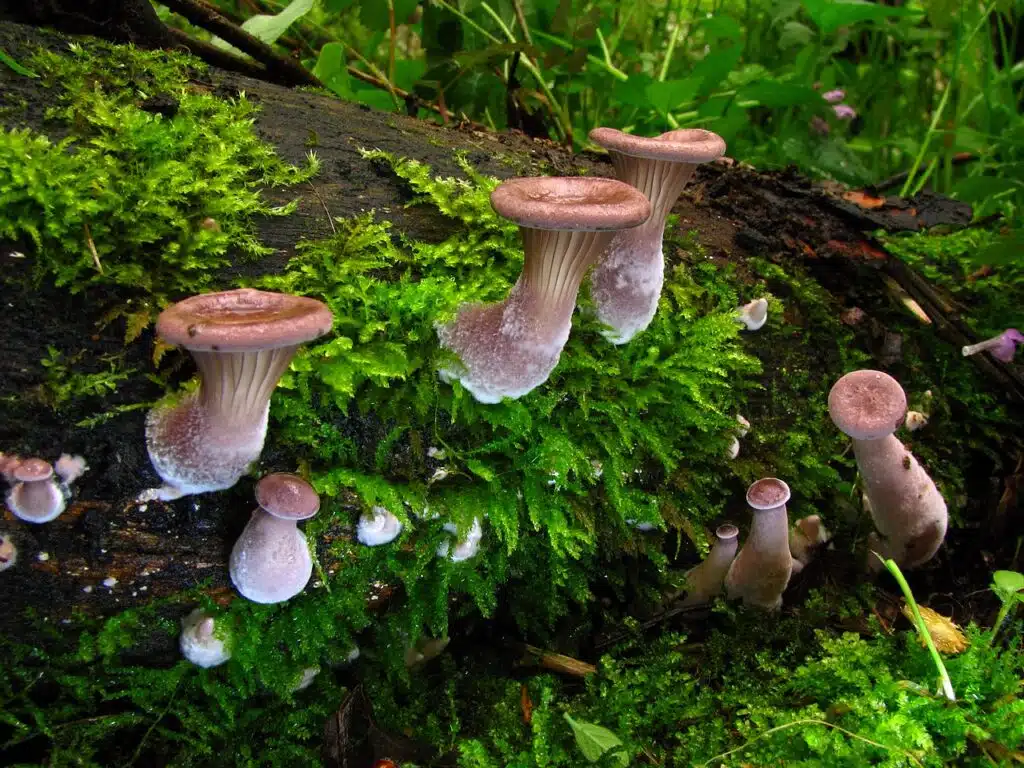
Lilac Oysterlings (Panus conchatus) are named after their shape which resembles oysters.
Various shades of lilac and purple are seen on these mushrooms, particularly of brighter nuances.
They can be found in the forests of Europe and North America and are associated with oak trees.
Lilac Oysterlings only grow on dead oak. They arise in groups on oak logs and old oak branches on the ground.
As they grow, these mushrooms can even change colors to a brown-dominated appearance.
They are considered not edible and even poisonous by some authors.
Unlike other mushrooms that grow on dead oak, Lilac Oysgterlings can be quite large. Some of the largest mushrooms of this type grow to a diameter of almost 9 inches.
12. Plums-and-Custard
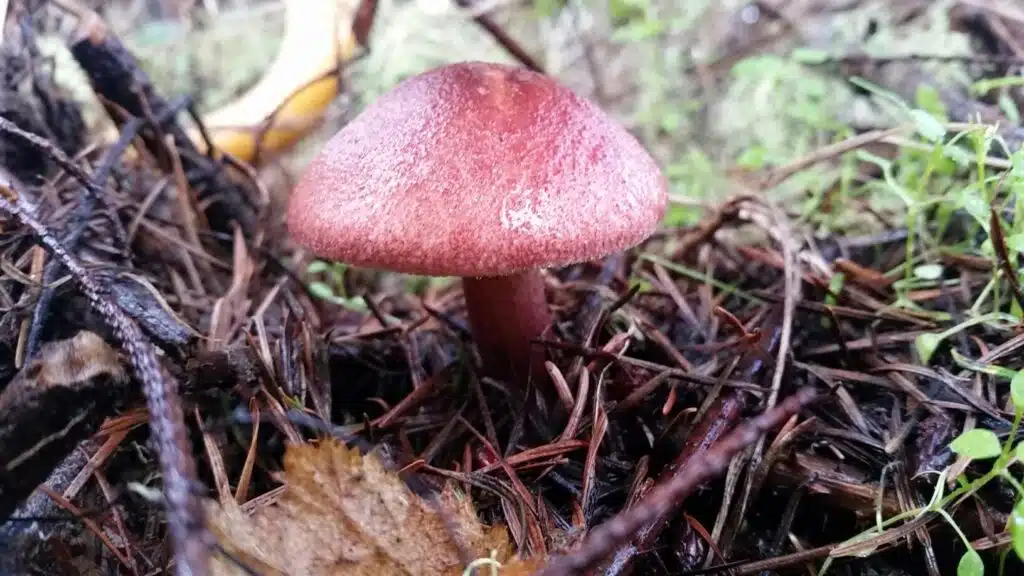
A type of bright purple mushroom, Plums-and-Custard (Tricholomopsis rutilans) are native to Europe and North America.
They arise in large numbers around dead pine tree roots. Their cap is hat-shaped at first, slowly becoming flattened as it spreads out with growth.
Golden-yellow nuances are specific to its gills and inspire the dual color name of this species.
Purple and white sections are further distinguished on the stem.
Mainly found across European woodlands, these types of mushrooms can also grow tall on dead wood.
They aren’t edible and are also bad-tasting.
13. Silverleaf Fungus
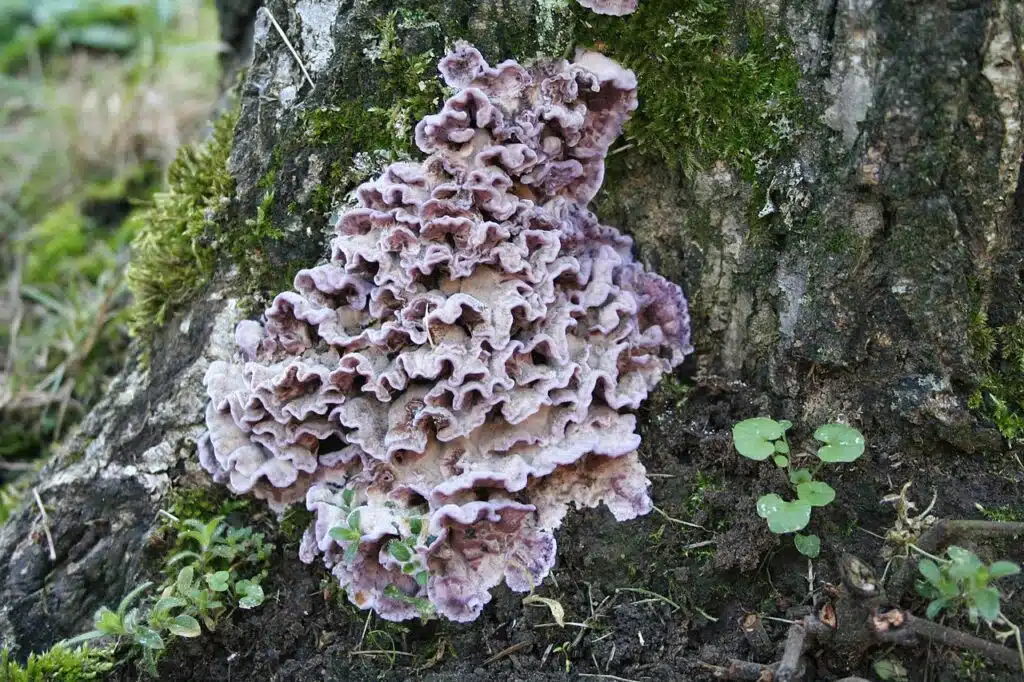
White, pink, and purple nuances are seen on Silverleaf Fungus (Chondrostereum purpureum).
When it starts to grow, The Silverleaf Fungus has a brighter appearance, eventually becoming dark purple with white margins.
Spreading out to several inches, this is also a fungus that doesn’t have a season as it can appear on plants and trees at any moment throughout the year.
Some of the places it can be spotted in are woodlands and parks of Europe and North America.
This species doesn’t have a silver appearance as its name is inspired by the silver leaves it causes in the plants it infests.
The poisonous fungus spreads quickly by air and typically attacks exposed sap areas of a living tree after first growing on dead trees and plants in the area.
Some of the most impacted species include roses but it also impacts trees such as maple and beech.
Much of its fungi spread is also considered poisonous to humans. Silverleaf fungi cannot be eaten, even if previously cooked.
14. Amethyst Deceiver
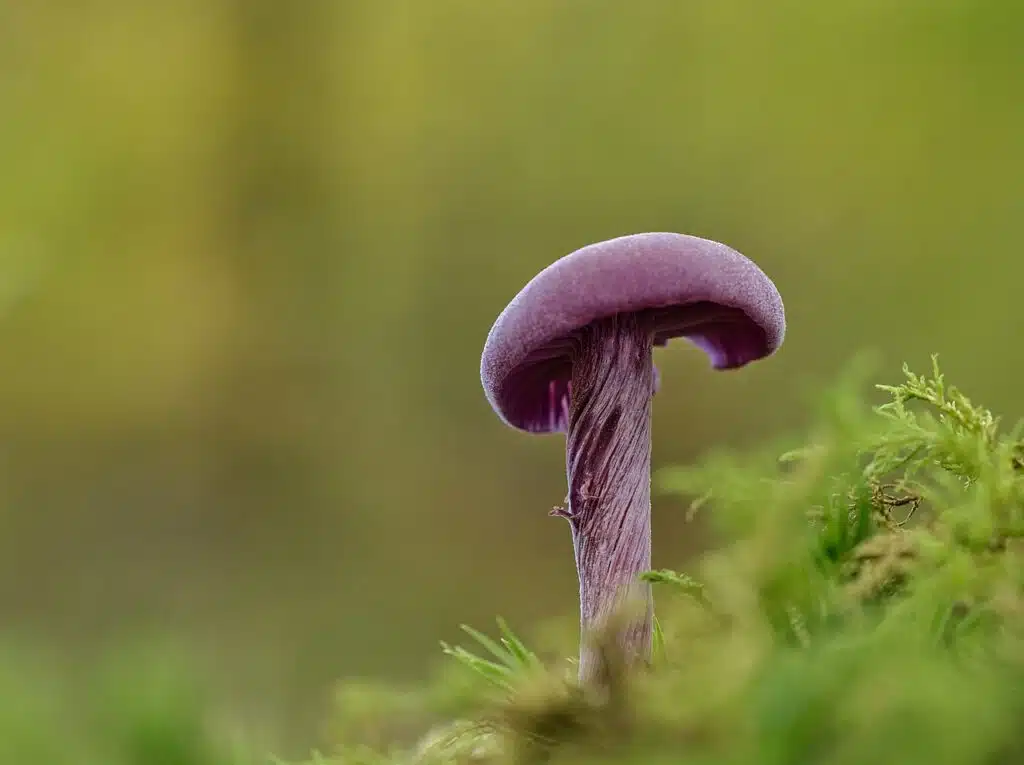
Amethyst Deceivers (Laccaria amethystina) are named after their changing amethyst or lavender-purple nuance.
These mushrooms brighten over time, which can make their identification troublesome.
The Americas and Europe mark the continents where the species grows. Its main associations are with beech and oak.
Growing in temperate forests, these mushrooms can reach a cap diameter of 1-3 inches and may be spotted in hardwood forests as well as in some coniferous forests.
Soil that has been improved with ammonia is also known to favor the mushrooms.
Known for their purple caps and purple stipe, these mushrooms are also seen late in the season with a sustained growth rate up until the winter.
Amethyst Deceivers are further responsible for absorbing some of the soil contaminants in their areas which doesn’t recommend them for eating.
While the mushrooms aren’t poisonous, they aren’t tasty and viable for picking either.
15. Purple Pinwheel
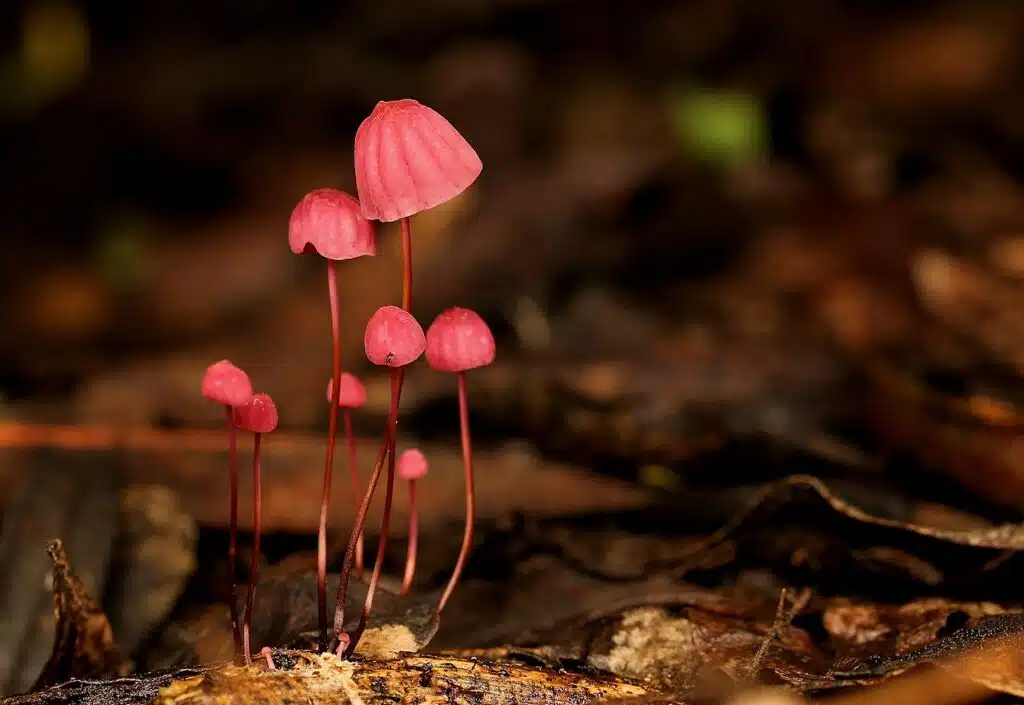
Purple Pinwheels (Marasmius haematocephalus) are some of the smallest and most colorful mushrooms in the world.
Spread across The Americas, Purple Pinwheels have a bright purple and wavy cap that resembles a small umbrella.
They also have a very thin stipe that is also purple.
When it comes to their size, they can grow to a height of up to several inches but are mostly just up to 0.5 inches high.
Preferring dead trees, they appear on logs and buried branches in deciduous woodlands.
The growth and spread rate of Purple Pinwheels is high. Mushrooms of the species may eventually even cover a dead tree completely, spreading to their hundreds.
Large clusters of Purple Pinwheels can also grow on the ground on decaying vegetation.
16. Purple-spored Puffball

A type of purple puffball, this type of mushroom (Calvatia cyathiformis) doesn’t have a traditional type of stipe as it looks like an actual ball.
Its purple color is acquired over time as young Purple-spored Puffballs are initially brown.
The tan-brown color then starts to change into a dark purple nuance which covers its entire mass.
Growing on the ground, Purple-spored Puffballs are mostly found in forests and next to trees.
They are present in Southern Australia and North America.
Its edible status is unclear but it’s believed the Purple-spored Puffball has no distinct taste, adding no value to a dish.
Those that do decide to pick the puffball do so in its early stages.
Its early tan color is the only period when the species can be picked for cooking.
17. Purplepore Bracket

Purplepore Brackets (Trichaptum abietinum) grow on dead timber in woodlands.
It has an initial dark purple nuance in its early days. This color starts to fade over time.
The final color is similar to cream with purple sections only specific to its margins.
There’s no stipe with these mushrooms as they grow directly in timber. With a very thin profile, Purplepore Brackets are also known to grow in layers.
Multiple layers are specific to this species as it grows. Tens of layers are specific to the species that have already grown for weeks and months.
As with many types of purple mushrooms that grow on dead trees, Purplepore Brackets don’t have a specific season as they grow throughout the year.
18. Western Amethyst Laccaria
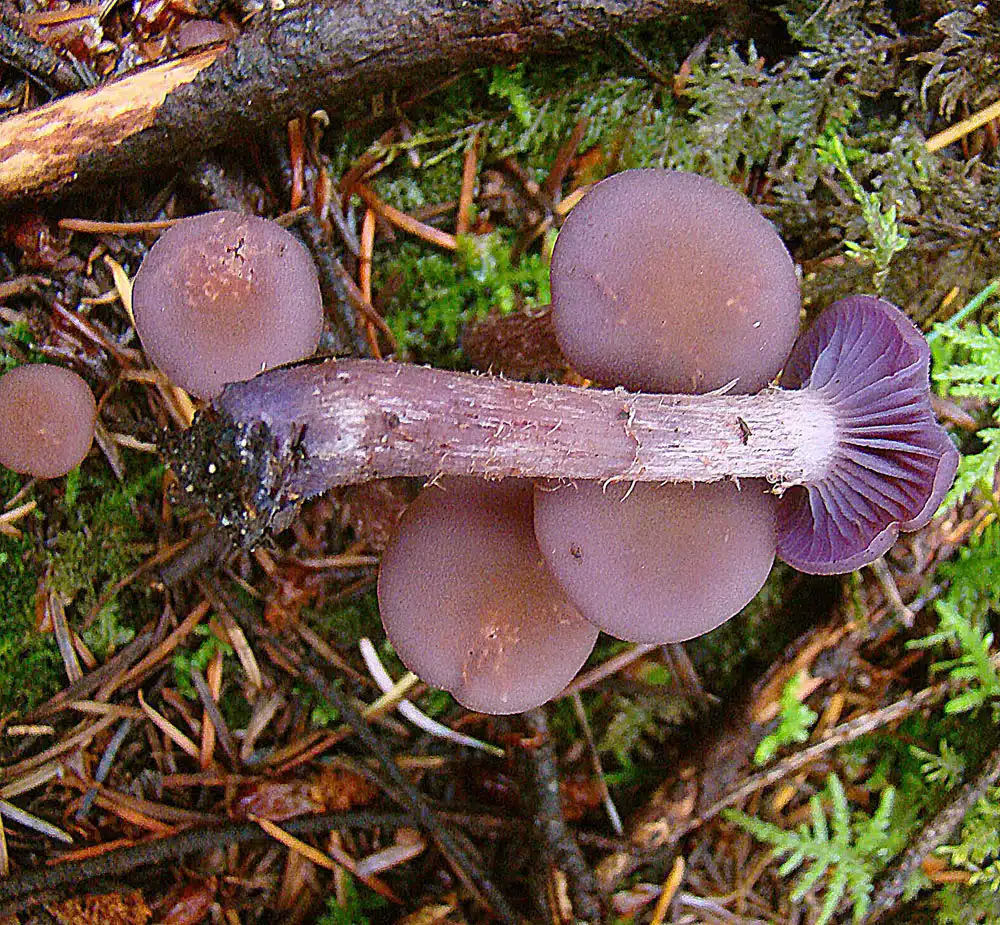
Western Amethysts (Laccaria amethysteo-occidentalis) are a species of purple mushrooms found in Western North America.
This is a species dominated by multiple nuances of purple.
Its cap has a brighter purple nuance which is sometimes described as purple-gray in its later growth stages.
The most vivid purple nuance is specific to its gills which are also thick and clearly separated.
Its stipe shows both purple and white nuances with the darker purple areas specific to the base and the white section specific to the area close to the cap.
The species is edible but its taste doesn’t add anything substantial to a dish.
Western Amethysts also grow individually and scarcely across their natural range West of The Rocky Mountains.
Picking more than a few is a rare occurrence.
Coniferous woodlands are among its preferred areas where it may grow quickly with the rain of the fall.
19. Reddish Brown Bitter Bolete

The purple nuances of The Reddish Brown Bitter Bolete (Tylopilus rubrobrunneus) are sporadic throughout its life.
As its name implies, this type of mushroom is dominated by red-brown nuances on its cap.
These nuances are mostly specific to its later growth stages as the cap can also have a purple-brown nuance.
Known for its wide and tapered stipe, the species also has a yellow-tan nuance specific to the stipe with a white section closer to the cap.
These mushrooms eventually become darker brown as they reach their maximum growth stage but they may still maintain some purple hues even in their later stages.
Growing in deciduous forests next to oak trees, the mushrooms are representative of large species which are edible.
While they can be eaten, Reddish Brown Bitter Bolete is believed to be too bitter to eat.
20. Violet Gray Bolete

Violet Gray Boletes (Tylopilus plumbeoviolaceus) are specific to the Eastern sides of North and Central America.
This is a species that grows in larger numbers in deciduous and sometimes coniferous forests and it’s known for its dual purple and brown appearance.
Initially purple, the cap of the mushroom slowly turns dark brown as the species grows.
The stipe is bright purple, turning to purple-brown as it grows.
Its thick stipe has a tapered shape, being narrower towards the fruit body,
The species is a common sight in woodlands where it grows in clusters and can be picked.
While Violet Gray Boletes aren’t poisonous, they aren’t good-tasting either.
A bitter taste is specific to these mushrooms and a small quantity can impact the entire dish. Boiling or grilling the fruit bodies doesn’t eliminate its unpleasant aroma.
21. Purple-edge Bonnet

Some of the smallest types of purple fungi are Purple-edge Bonnets (Mycena purpureofusca).
Growing to a size of up to 2 inches, these types of fungi are bright brown on the cap at first.
As they grow, they become slightly purple, specifically towards the edges of the cap while the raised central section remains brown.
A brown-purple stipe is also specific to these fungi, albeit mostly dominated by a darker nuance.
Purple-edge Bonnets are mostly reported in European forests where they grow in large numbers on logs and dead trees.
Some of them are found on hardwood trees while other Purple-edge Bonnets grow on dead pines and even on pine cones.
As with different types of dead wood fungi, they also tend to grow in clusters, often covering entire logs.
22. Hairy Oyster Mushroom
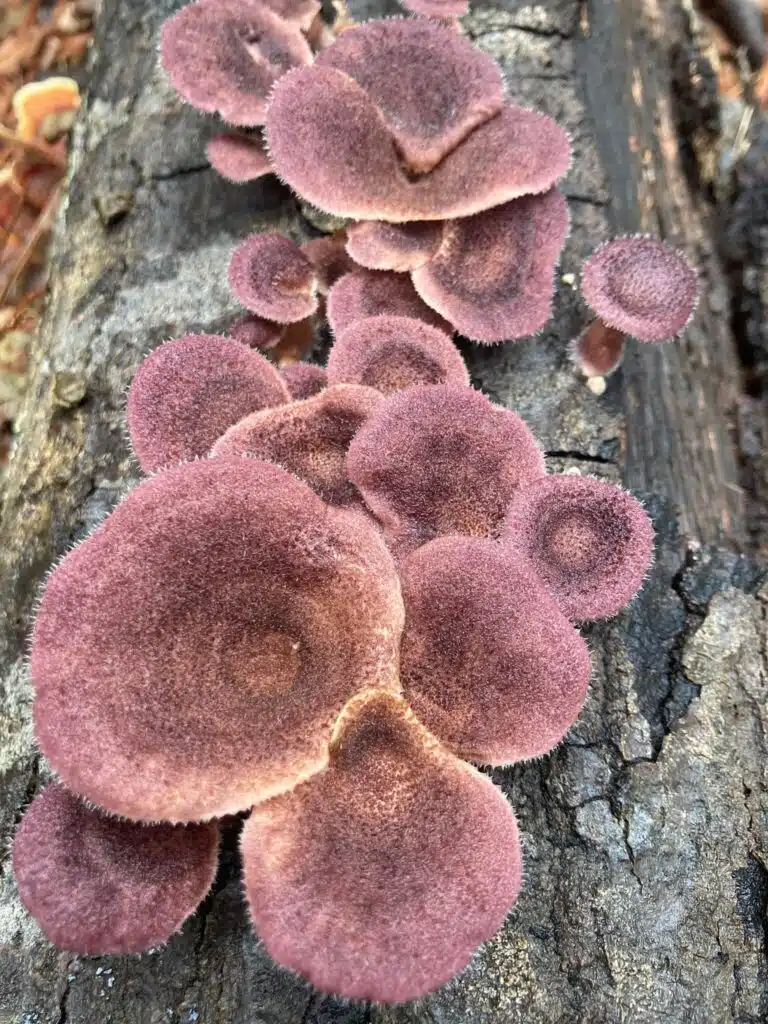
Hairy Oyster Mushrooms (Panus lecomtei) are named after the short white hairs that cover their caps.
Unlike Purple-edge Bonnets which only show tiny white hairs in their early days, the white hairs persist on Hairy Oyster Mushrooms.
This is a species that eventually turns brown from an initial purple cap nuance.
Its growing season is long, spreading from late spring to late fall in temperate climates.
Hairy Oyster Mushrooms are reported in Europe, North America, and Asia.
The oyster-shaped species are edible and one of the healthiest types of purple mushrooms in The Northern Hemisphere.
Studies show Hairy Oyster Mushrooms contain high amounts of antioxidants and are known for their low-fat percentage.
23. Gassy Webcap
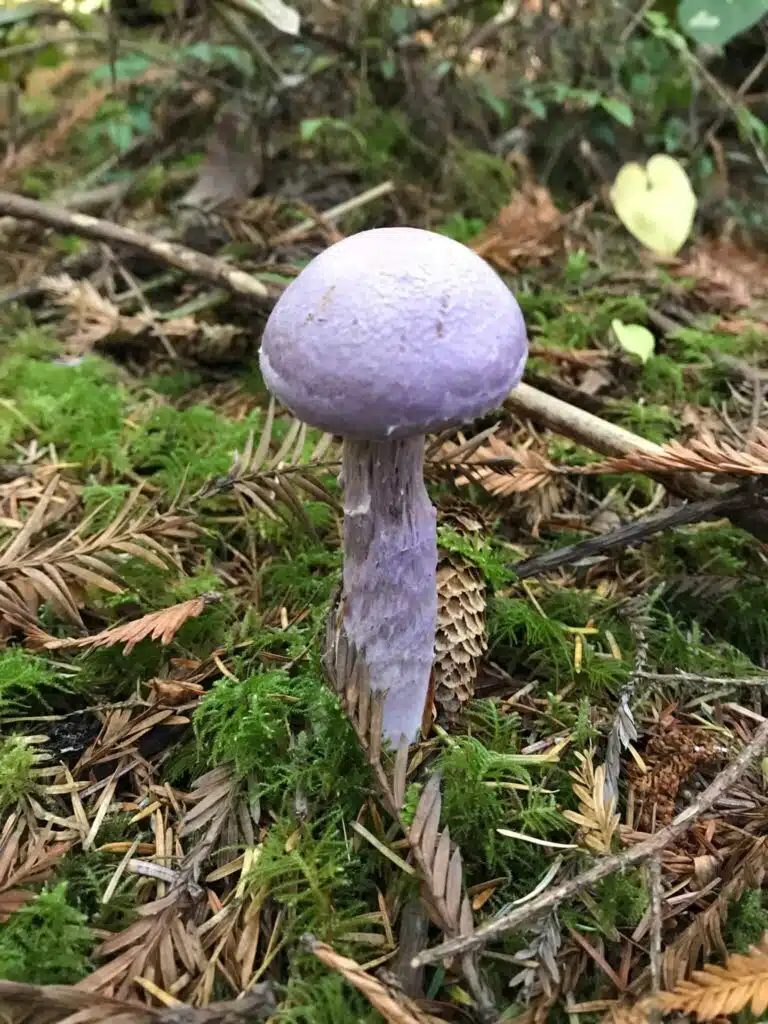
As Hairy Oyster Mushrooms, Gassy Webcaps (Cortinarius traganus) are among the purple mushrooms that grow in coniferous woodlands in North America.
However, these mushrooms are highly poisonous even when cooked. Some reports say the species isn’t poisonous but its similarity to poisonous species doesn’t recommend it for picking.
Its cap shows a mostly purple nuance with yellow spots while its stipe is also partly purple and partly yellow.
Known for its sour taste, the mushroom has cream cap flesh and yellow stiped flesh.